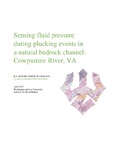| dc.rights.license | In Copyright | en_US |
| dc.creator | Wilkinson, Clare E. | |
| dc.date.accessioned | 2017-06-19T14:50:25Z | |
| dc.date.available | 2017-06-19T14:50:25Z | |
| dc.date.created | 2017 | |
| dc.identifier | WLURG38_Wilkinson_GEOL_2017 | |
| dc.identifier.uri | http://hdl.handle.net/11021/33911 | |
| dc.description | Thesis; [FULL-TEXT FREELY AVAILABLE ONLINE] | en_US |
| dc.description | Clare E. Wilkinson is a member of the Class of 2017 of Washington and Lee University. | en_US |
| dc.description.abstract | Bedrock river erosion by plucking -- the wholesale removal of bedrock blocks -- is likely the dominant non-glacial driver of incision into topography over both short- and long-term timescales. Engineering and physical/numerical modeling inform most of our understanding of plucking because the process is difficult and often dangerous to observe and measure in natural channels. Model studies detail controls on the plucking process, including block size, protrusion factor and head change due to hydraulic structures. Engineering studies detail pressure pulse transmission through the joint network of concrete blocks from impinging jets. Natural channels with jointed or fractured bedrock likely also experience a transmission of pressure through the crack network.
Instrumentation of a natural bedrock block is designed to test plucking caused by fluid pressure propagation through the sub-block and crack network. Herein I outline the procedure of designing and constructing a waterproof housing for a suite of electronics that record fluid pressure and movement of a natural bedrock block. To investigate pressure transmission through the sub-block network, I drilled a hole through a bedrock block and installed two MS5308 fluid pressure sensors flush with the top and bottom of a bedrock block. I installed an MPU6050 accelerometer/gyroscope to understand block movement associated with pressure fluctuations. The sensors record data at 40 samples/sec with great sensitivity.
The study site on the Cowpasture River in Bath County, VA is characterized by 5 bedrock steps, each of which produce a hydraulic jump and train of standing waves. An estimated discharge of ~6230 cfs is a minimum for plucking to occur; this discharge was not achieved during the test period but is achievable in a 2- to 5-year flood event. | en_US |
| dc.description.statementofresponsibility | Clare Elizabeth Wilkinson | |
| dc.format.extent | 55 pages | en_US |
| dc.language.iso | en_US | en_US |
| dc.rights | This material is made available for use in research, teaching, and private study, pursuant to U.S. Copyright law. The user assumes full responsibility for any use of the materials, including but not limited to, infringement of copyright and publication rights of reproduced materials. Any materials used should be fully credited with the source. | en_US |
| dc.rights.uri | http://rightsstatements.org/vocab/InC/1.0/ | en_US |
| dc.subject.other | Washington and Lee University -- Honors in Geology | en_US |
| dc.title | Sensing Fluid Pressure During Plucking Events in a Natural Bedrock Channel: Cowpasture River, VA (thesis) | en_US |
| dc.type | Text | en_US |
| dcterms.isPartOf | RG38 - Student Papers | |
| dc.rights.holder | Wilkinson, Clare E. | |
| dc.subject.fast | Sandstone -- Testing | en_US |
| dc.subject.fast | Sedimentation and deposition | en_US |
| dc.subject.fast | Shields (Geology) | en_US |
| dc.subject.fast | Virginia -- Bath County | en_US |
| local.department | Geology | en_US |
| local.scholarshiptype | Honors Thesis | en_US |
